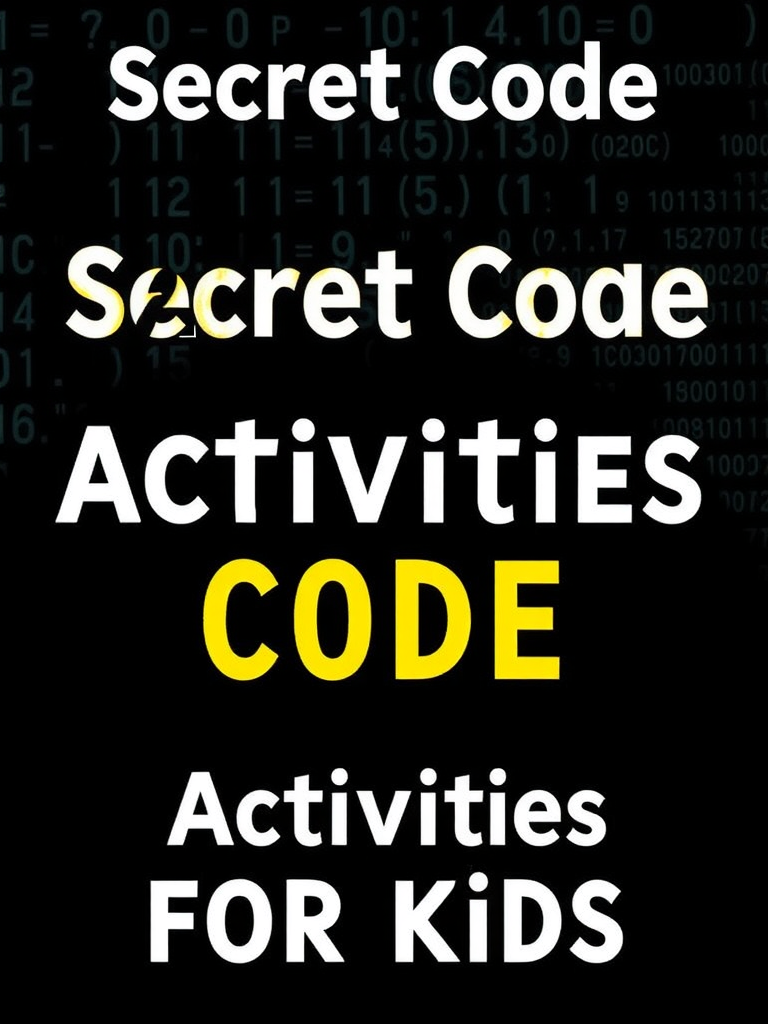
Introduction
Secret Code Activities for Kids are a fantastic way to stimulate young minds, enhance problem-solving skills, and provide hours of entertainment. Whether you’re a parent, teacher, or caregiver, introducing children to the world of secret codes can be both educational and fun. In this article, we’ll explore seven exciting secret code activities that you can easily set up at home. These activities are designed to be simple, engaging, and suitable for kids of various ages.
Why Secret Code Activities for Kids?
Secret Code Activities for Kids offer numerous benefits:
- Enhance Problem-Solving Skills: Deciphering codes requires logical thinking and attention to detail.
- Boost Creativity: Creating and solving codes encourages imaginative thinking.
- Improve Literacy: Many codes involve letters and words, helping kids practice reading and writing.
- Promote Teamwork: Working together to crack codes fosters collaboration and communication.
- Provide Screen-Free Entertainment: These activities are a great way to engage kids without relying on electronic devices.
7 Fun Secret Code Activities for Kids
1. The Classic Caesar Cipher
The Caesar Cipher is one of the simplest and most well-known encryption techniques. It involves shifting each letter in the alphabet by a fixed number of positions.
How to Create a Caesar Cipher:
- Choose a shift number (e.g., 3).
- Write down the alphabet.
- Shift each letter by the chosen number (e.g., A becomes D, B becomes E, etc.).
- Use the shifted alphabet to encode your message.
Example:
- Original Message: HELLO
- Encoded Message: KHOOR (shift of 3)
2. Morse Code
Morse Code uses a series of dots and dashes to represent letters and numbers. It’s a great way to introduce kids to the concept of binary communication.
How to Use Morse Code:
- Provide a Morse Code chart to the kids.
- Have them practice translating simple words into Morse Code.
- Use a flashlight or a tapping sound to send Morse Code messages.
Example:
- HELLO in Morse Code: …. . .-.. .-.. —
3. Pigpen Cipher
The Pigpen Cipher uses a grid of symbols to represent letters. It’s a fun and visual way to encode messages.
How to Create a Pigpen Cipher:
- Draw two grids with nine squares each.
- Fill the grids with letters (A-I in the first grid, J-R in the second, and S-Z in a modified grid).
- Assign a unique symbol to each square.
- Use the symbols to encode your message.
Example:
- The letter A might be represented by a square with a dot in the center.
4. Invisible Ink
Invisible Ink is a classic spy technique that kids love. You can use lemon juice, milk, or baking soda to write secret messages.
How to Use Invisible Ink:
- Write a message using lemon juice or another invisible ink.
- Let the paper dry completely.
- To reveal the message, heat the paper with a light bulb or iron.
5. Number Substitution
Number Substitution involves replacing each letter with a corresponding number (A=1, B=2, etc.).
How to Use Number Substitution:
- Assign a number to each letter of the alphabet.
- Write your message using numbers instead of letters.
- Provide a key for decoding.
Example:
- HELLO becomes 8 5 12 12 15.
6. Reverse Alphabet
The Reverse Alphabet code is simple yet effective. It involves writing the alphabet backward and substituting each letter with its reverse counterpart.
How to Use Reverse Alphabet:
- Write the alphabet in reverse order (Z=A, Y=B, etc.).
- Use the reverse alphabet to encode your message.
Example:
- HELLO becomes SVOOL.
7. Symbol Substitution
Symbol Substitution replaces each letter with a unique symbol or picture. This can be as simple or complex as you like.
How to Use Symbol Substitution:
- Create a key that assigns a symbol to each letter.
- Write your message using the symbols.
- Provide the key for decoding.
Example:
- The letter A might be represented by a star, B by a heart, etc.
Tips for Successful Secret Code Activities for Kids
- Start Simple: Begin with basic codes and gradually increase complexity.
- Provide Clues: Offer hints or partial keys to help kids get started.
- Make It Fun: Incorporate themes or stories to make the activities more engaging.
- Encourage Creativity: Let kids create their own codes and challenge others to solve them.
- Use Real-Life Scenarios: Create scenarios where kids have to use codes to solve a mystery or find a hidden treasure.
Conclusion
Secret Code Activities for Kids are a wonderful way to combine learning and fun. By introducing children to different types of codes and ciphers, you can help them develop critical thinking skills, enhance their creativity, and provide them with a unique form of entertainment. Whether you’re using the classic Caesar Cipher, experimenting with invisible ink, or creating your own symbol substitution, these activities are sure to captivate and educate. So gather your materials, set up your codes, and let the adventure begin!
For more creative activities and ideas, check out our Game Design & Art section.
FAQs
Q: What age group are these Secret Code Activities for Kids suitable for?
A: These activities can be adapted for kids of all ages, from preschoolers to teenagers. The complexity of the codes can be adjusted based on the child’s age and skill level.
Q: Do I need any special materials for these activities?
A: Most of these activities require only basic materials like paper, pens, and household items like lemon juice or baking soda. Some activities may require a flashlight or a heat source for invisible ink.
Q: How can I make these activities more challenging for older kids?
A: You can increase the complexity of the codes, use multiple layers of encryption, or create longer and more intricate messages. You can also introduce more advanced ciphers like the Vigenère Cipher or the Playfair Cipher.
Q: Can these activities be done in a group setting?
A: Absolutely! These activities are great for group settings, such as classrooms, birthday parties, or playdates. Kids can work together to solve codes or compete to see who can crack the code first.
Q: Are there any online resources for more Secret Code Activities for Kids?
A: Yes, there are many online resources available. For example, Picklebums offers a variety of fun and educational secret code activities for kids.
By incorporating these Secret Code Activities for Kids into your routine, you can provide a stimulating and enjoyable experience that promotes learning and creativity. Happy coding!

Game Engine Architecture
In this new and improved third edition of the highly popular Game Engine Architecture,

Results
Razer BlackShark V3 X HyperSpeed Wireless Gaming Headset for PS5: 50mm Drivers - Cardioid Mic - 2.4 GHz, Bluetooth - Works with PC, Mac, Nintendo Switch, Smartphone - Long Battery Life - Black

